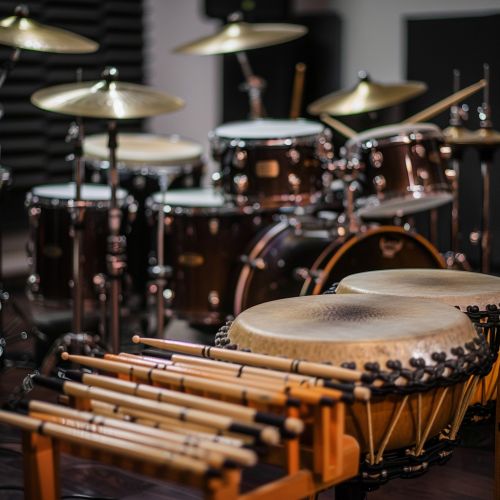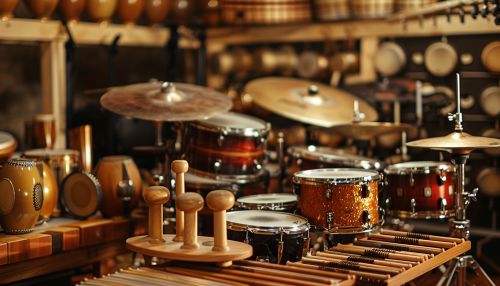Percussion instrument
Introduction
A percussion instrument is a musical instrument that produces sound by being struck, shaken, or scraped by a beater, hand, or another similar object. Percussion instruments are integral to many musical traditions worldwide and are used in various contexts, from classical orchestras to contemporary music ensembles. They are known for their ability to produce a wide range of sounds and rhythms, making them versatile and essential in many musical compositions.
Classification of Percussion Instruments
Percussion instruments can be broadly classified into two main categories: pitched percussion instruments and unpitched percussion instruments.
Pitched Percussion Instruments
Pitched percussion instruments produce notes with a definite pitch. These instruments are often used to play melodies and harmonies in addition to rhythms. Examples of pitched percussion instruments include:
- Xylophone: A xylophone consists of wooden bars of varying lengths that are struck with mallets. Each bar is tuned to a specific pitch.
- Marimba: Similar to the xylophone, the marimba has wooden bars but typically produces a warmer and deeper sound.
- Glockenspiel: This instrument features metal bars and produces a bright, bell-like sound.
- Timpani: Also known as kettledrums, timpani are large drums with a tunable membrane that can produce specific pitches.
Unpitched Percussion Instruments
Unpitched percussion instruments do not produce a definite pitch. They are primarily used to provide rhythm and texture in a musical piece. Examples of unpitched percussion instruments include:
- Snare drum: Known for its sharp, staccato sound, the snare drum is a staple in both orchestral and marching band music.
- Bass drum: This large drum produces a deep, resonant sound and is often used to emphasize the beat.
- Cymbals: These metal plates are struck together or with a stick to produce a crashing sound.
- Triangle: A small, triangular metal bar that produces a bright, ringing tone when struck.
Historical Development
The history of percussion instruments dates back to ancient times. Early humans used natural objects such as stones and sticks to create rhythmic sounds. Over time, these primitive instruments evolved into more sophisticated forms.
Ancient Civilizations
In ancient civilizations, percussion instruments played a significant role in religious and ceremonial contexts. For example, the Egyptians used sistrums, a type of rattle, in their rituals. Similarly, the Mesopotamians used frame drums and cymbals in their religious ceremonies.
Medieval and Renaissance Periods
During the medieval and Renaissance periods, percussion instruments became more diverse and complex. The use of percussion in military contexts also became prominent, with instruments such as the tabor (a small drum) and the nakers (small kettledrums) being used to signal troops.
Baroque and Classical Periods
The Baroque and Classical periods saw the formalization of the orchestra, with percussion instruments being integrated into orchestral compositions. Composers like Johann Sebastian Bach and Ludwig van Beethoven began to include timpani in their works, recognizing the instrument's ability to add dramatic effect and rhythmic drive.
Modern Era
In the modern era, the range of percussion instruments has expanded significantly. The 20th century saw the introduction of new instruments such as the vibraphone and the drum kit. Contemporary composers and musicians continue to explore the possibilities of percussion, incorporating electronic and unconventional instruments into their works.
Construction and Materials
The construction and materials of percussion instruments vary widely, depending on the type and intended use of the instrument.
Membranophones
Membranophones, such as drums, produce sound through the vibration of a stretched membrane. The membrane, often made of animal skin or synthetic materials, is stretched over a frame or shell. The tension of the membrane can be adjusted to change the pitch and tone of the instrument.
Idiophones
Idiophones produce sound through the vibration of the instrument's body itself. This category includes instruments like the xylophone, marimba, and cymbals. The materials used for idiophones can range from wood and metal to glass and stone.
Electrophones
Electrophones are a more recent addition to the percussion family. These instruments produce sound electronically or amplify acoustic sounds using electronic means. Examples include electronic drum kits and digital percussion pads.
Techniques and Playing Methods
Percussion instruments can be played using various techniques and methods, depending on the instrument and the desired sound.
Striking
Striking is the most common method of playing percussion instruments. This can be done with hands, sticks, mallets, or other beaters. The type of beater used can significantly affect the sound produced. For example, soft mallets produce a mellow tone on a marimba, while hard mallets produce a brighter, more percussive sound.
Shaking
Shaking is used to play instruments like maracas and tambourines. The motion of shaking causes small objects within the instrument to strike against its body, producing sound.
Scraping
Scraping involves dragging a stick or other object across a surface to produce sound. Instruments like the guiro and the washboard are played using this technique.
Bowing
Bowing is a less common technique used with some percussion instruments, such as the musical saw and the vibraphone. A bow is drawn across the edge of the instrument to produce a sustained, resonant sound.
Role in Different Musical Genres
Percussion instruments play a vital role in various musical genres, each utilizing the instruments in unique ways.
Classical Music
In classical music, percussion instruments are used to add color, rhythm, and dramatic effect. The timpani, snare drum, and cymbals are commonly found in orchestral compositions. Composers like Igor Stravinsky and Dmitri Shostakovich have written works that prominently feature percussion.
Jazz
Jazz music often features a drum kit, which includes a bass drum, snare drum, tom-toms, hi-hat, and cymbals. The drum kit provides the rhythmic foundation for jazz ensembles. Percussion instruments like the vibraphone and congas are also used in jazz to add texture and complexity.
Rock and Pop
In rock and pop music, the drum kit is essential for driving the rhythm and providing energy. Percussion instruments like tambourines, shakers, and electronic drums are also commonly used to add variety and depth to the music.
World Music
Percussion instruments are central to many world music traditions. For example, in African music, drums like the djembe and talking drum are used for communication and storytelling. In Latin American music, instruments like the bongos, congas, and timbales are essential for creating the characteristic rhythms of genres like salsa and samba.
Notable Percussion Instruments
Some percussion instruments have gained particular prominence due to their unique sound and historical significance.
Steelpan
The steelpan, originating from Trinidad and Tobago, is made from a steel drum and produces a melodic, resonant sound. It is a key instrument in Caribbean music and has gained international recognition.
Tabla
The tabla is a pair of drums used in Indian classical music. It is known for its complex rhythms and intricate playing techniques. The tabla has a rich history and is integral to many Indian musical traditions.
Cajón
The cajón is a box-shaped percussion instrument from Peru. It is played by striking the front face with hands, fingers, or brushes. The cajón is widely used in flamenco, Afro-Peruvian music, and contemporary genres.
Djembe
The djembe is a goblet-shaped drum from West Africa. It is played with bare hands and is known for its wide range of tones and dynamic capabilities. The djembe is often used in traditional ceremonies and modern performances.
Innovations and Modern Developments
The field of percussion has seen numerous innovations and developments in recent years.
Electronic Percussion
Electronic percussion instruments, such as electronic drum kits and digital percussion pads, have become increasingly popular. These instruments offer a wide range of sounds and effects, allowing musicians to experiment with new textures and rhythms.
Hybrid Instruments
Hybrid percussion instruments combine acoustic and electronic elements. For example, a hybrid drum kit may include traditional drums and cymbals alongside electronic pads and triggers. This allows for greater versatility and creative possibilities.
Extended Techniques
Contemporary percussionists often use extended techniques to explore new sounds and effects. This can include using unconventional objects as beaters, preparing instruments with additional materials, or incorporating non-traditional playing methods.
Conclusion
Percussion instruments are a diverse and dynamic family of musical instruments that have played a crucial role in music throughout history. From ancient rituals to modern performances, percussion instruments continue to evolve and inspire musicians and audiences alike. Their ability to produce a wide range of sounds and rhythms makes them indispensable in many musical traditions and genres.


